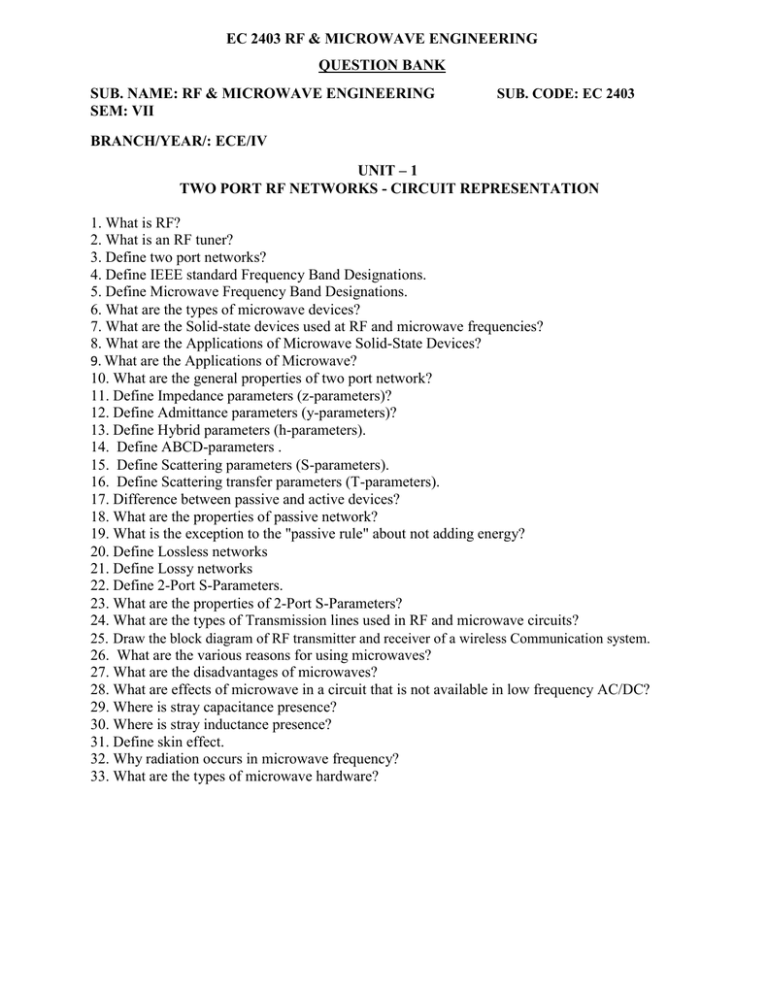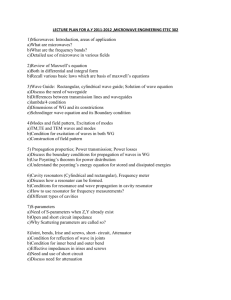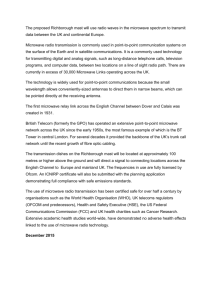ALL unit 1-5 questions
advertisement

EC 2403 RF & MICROWAVE ENGINEERING QUESTION BANK SUB. NAME: RF & MICROWAVE ENGINEERING SEM: VII SUB. CODE: EC 2403 BRANCH/YEAR/: ECE/IV UNIT – 1 TWO PORT RF NETWORKS - CIRCUIT REPRESENTATION 1. What is RF? 2. What is an RF tuner? 3. Define two port networks? 4. Define IEEE standard Frequency Band Designations. 5. Define Microwave Frequency Band Designations. 6. What are the types of microwave devices? 7. What are the Solid-state devices used at RF and microwave frequencies? 8. What are the Applications of Microwave Solid-State Devices? 9. What are the Applications of Microwave? 10. What are the general properties of two port network? 11. Define Impedance parameters (z-parameters)? 12. Define Admittance parameters (y-parameters)? 13. Define Hybrid parameters (h-parameters). 14. Define ABCD-parameters . 15. Define Scattering parameters (S-parameters). 16. Define Scattering transfer parameters (T-parameters). 17. Difference between passive and active devices? 18. What are the properties of passive network? 19. What is the exception to the "passive rule" about not adding energy? 20. Define Lossless networks 21. Define Lossy networks 22. Define 2-Port S-Parameters. 23. What are the properties of 2-Port S-Parameters? 24. What are the types of Transmission lines used in RF and microwave circuits? 25. Draw the block diagram of RF transmitter and receiver of a wireless Communication system. 26. What are the various reasons for using microwaves? 27. What are the disadvantages of microwaves? 28. What are effects of microwave in a circuit that is not available in low frequency AC/DC? 29. Where is stray capacitance presence? 30. Where is stray inductance presence? 31. Define skin effect. 32. Why radiation occurs in microwave frequency? 33. What are the types of microwave hardware? 34. What are the characteristic features of microwave? 35. Define scattering transfer parameters. UNIT -2 RF TRANSISTOR AMPLIFIER DESIGN AND MATCHING NETWORKS 1. Define Transducer power gain. 2. Define Unilateral power gain(GT U). 3. Define Available power gain (GA). 4. Define Operating power gain (G). 5. Define Available power. 6. Define Stability circles. 7. Give the condition for stability circle. 8. Define Input stability circle equation. 9. Define Output stability circle equation. 10. Define Input and Output circle radius for stability equation? 11. Define Unilateral Figure of Merit. 12. Define Noise Figure Circles. 13. Define impedance matching networks. 14. Define unconditional stability. 15. Define noise parameter. 16. What are the advantages of matching network? 17. What are the designing methods in matching network? 18. Define analytical method. 19. What are the advantages of graphical method? 20. Define nodal factor (Qn). 21. What are factors affected the stability circle? 22. What is the practical draw back in unilateral design approach? 23. Define bilateral design. 24. What is simultaneous conjugate match? 25. Define Minimum Noise Figure and its equivalent noise resistance. 26. Define constant VSWR circles in bilateral approach. 27. What is mean by wavelength towards generator? 28. What are the types of matching components? 29. What are key considerations for selection of networks? 30. Define Micro strip line matching network. UNIT – 3 MICROWAVE PASSIVE COMPONENTS 1. Define s-matrix 2. What are the .Properties of s-matrix? 3. Why is s-matrix used in MW analysis? 4. Give ABCD matrix for a two port network 5. What is ABCD matrix? 6. What are the advantages of ABCD matrix? 7. What is the Scattering matrix for N port device?. . 8. Give the S matrix of uniform transmission line 9. Give the properties of impedence [x]&admittance[y] matrix? 10. For a loss less junction all the elements in the impedence &admittance matrices are 11. What are the properties of scattering matrix for a lossless junction? 12. What is transmission matrix? 13. Define one port circuit. Give two examples. 14. Write the voltage matrix for an N-port microwave circuits. 15. For reciprocal media, the impendence and admittance matrices are 16. For non-reciprocal media,the impedence and admittance matrices are 17. Give two examples for two port junctions. 18. State the unique property of Scattering matrix? 19. Write the scattering matrix for a ideal waveguide section? 20. What are the various reasons pertaining to the wide use of microwaves? 21. What are the two types of terminations? 22. What are ferrites and give its properties? 23. Give some examples of ferrite devices? 24. List two microwave devices using faraday rotation principles. 25. What are power dividers? 26. What is the S-matrix of 3 port circulators? 27. Give the differences between Isolator and Circulator 28. What is the S-matrix for 4 port circulators? 29. Give the S-matrix of E-plane Tee. 30. Give the S-matrix of H-plane Tee. 31. Give the S-matrix of Magic Tee. 32. Give the Smatrix of directional coupler. 33. Give an example for a two port MW device. 34. Give the applications of directional coupler 35. What is Faraday’s rotation law? 36. Define VSWR 37. What is Gyrator? 38. What is the principle of Microwave phase shifter? 39. What are junctions? Give some examples 40. What is Tee junction? Give two examples 41. What is the other name for magic TEE? 42. What is hybrid ring? 43. What is the other name for Hybrid ring? 44. Name some wave guide components used to change the direction of the guide through an arbitrary angle 45. What are the different types of Directional coupler? 46. What are hybrid couplers? 47. What are nonreciprocal devices? Give tw o examples 48. Why isolators are called uniline? 49. Give some coupling parameters of directional coupler? UNIT -4 MICROWAVE SEMICONDUCTOR DEVCES 1. What are the Key phenomenon taking place in TRAPATT diode? 2.What is the operating frequency of TRAPATT devices? 3 What are the applications of TRAPATT devices? 4. What are the applications of Tunnel Diode? 5.What are the elements that exhibit Gunn effect? 6. What are the applications of Gunn Diode? 7. What is negative resistance? 8. What are the applications of Backward diode? 9. Why are FET’s preferred to bipolar transistor at high frequencies? 10. What is the main advantage of TRAPATT over IMPATT? 11.Draw the schematic diagram of PIN diode? 12. What is MESFET? 13. Explain stable amplification mode. 14. What are the factors reduc ing efficiency of IMPATT diode? 15. Explain plasma formation in TRAPATT diode. 16. What is negative resistance in gunn diode? 17 What are the applications of GaAsMESFET.? 18. What are the applications of TRAPATT? 19. What is Transferred electron effect? 20. What are time parameter for TED’S 21. What are the various modes of transferred electron oscillators? 22. List the type of circuit used for IMPATT diode circuits. 23. What are the applications of low Q-oscillators and amplifier circuits? 24. List some of power detecting elements? 25. What is microwave detector? 26. Differentiate baretter and thermistor? 27. Define GUNN EFFECT. UNIT – 5 MICROWAVE TUBES AND MEASUREMENTS 1. What are the high frequency effects in conventional tubes? 2. What are the assumptions for calculation of RF power in Reflex Klystron? 3. What is the condition for oscillation in Reflex klystron ? 4. Give the drawbacks of klystron amplifiers. 5. What is the effect of transit time? 6. What are the applications of reflex klystron ? 7. What is the purpose of slow wave structures used in TWT amplifiers? 8. How are spurious oscillations generated in TWT amplifier? State the method to suppress it. 9 State the applications of TWT. 10. How the klystron amplifier can act as klystron oscillator? What are the applications of klystron amplifier? 11. Define phase focusing effect. 12. What do you mean by O -type tubes? Name some O-type tubes. 13. Define Transit time in Reflex klystron. 14. Write the parameters on which bunching depend on? 15. Compare TWTA Klystron amplifier 16. Give the performance Specification of Reflex klystron? 17. What is CFA? State the applications of CFA. 18. State the characteristics of magnetron and of 2-cavity klystron amplifier. 19. What are the advantages of TWT? 20. What is meant by strapping? 21. State the applications of magnetrons. why magnetron is called as cross filed device? 22. What is BWO? State the applications of BWO. 23. What is hull cutoff condition? 24. What are the principal limitations of conventional negative grid electron tubes? 25. What is frequency pulling and frequency pushing in magnetrons? 26. What are the applications of High Q-oscillators and amplifier circuits? 27. What are tunable detector? 28. What is slotted section with line carriage? 29. What is the main purpose of slotted section with line carriage? 30. What is a VSWR meter? 31. What is Bolometer? 32. What is calorimeter? 33. Mention the disadvantages of single bridge circuit ? 34. Define insertion loss? 35. How will you determine the vswr and return loss in reflecto meter method? 36. List the different types of Impedence measurement methods? 37. How do you measure microwave frequency? 38. What is a wavemeter? 39. Define dielectric constant? 40. How the S-parameter of a microwave circuit measured? 41. List the methods for measuring dielectric constants? 42. What is radiation pattern? 43. What is radiation efficiency? 44. How do you measure the polarization? 45. What is spectrum analyzer? 46. List the types of spectrum analyzer 47. List some application of spectrum analyzer. 48. What is network analyzer?




